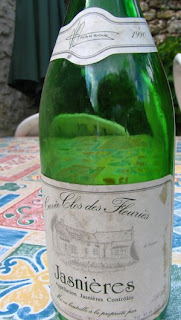The retiring chairman!
(11 August 2008: Sancerre trip)
I well remember the time I first met Jean-Marie. It was towards the end of October 1989, that famously wonderful vintage – both summer and autumn. On my way to Chavignol with friends we drove up through Bué – the autumn colours on the steep hillsides were breathtakingly beautiful. The Bourgeois were in the middle of their vendange tardive. Despite this not being the ideal time to receive a newly hatched journalist, we spent a memorable two hours or more with him.
Jean-Marie says he is now in semi-retirement but he is still traveling the world, including New Zealand to check up on Clos Henri, the Bourgeois outpost in Marlborough.
We started with a quick visit to the Bourgeois winery that is steadily making its way up the steep road out of Chavignol. Back in 1989 most of the Bourgeois operation – winery and offices – was crammed into one building. In 2000 work started on the new gravity winery, just above the old one. It is impressively hi-tech and functional – more functional than trying to buy wine bottles these days. "At the moment we have to order 6 to 8 months in advance,” Jean-Marie explained. 40% of the harvest is by hand, 60% by machine with all of the Pinot Noir picked by hand. They are now equipped for screwcap bottles.
For a company that now has 70 ha of vines plus contracts with other growers in various appellations such as Pouilly-Fumé and Quincy covering another 70 ha and a total annual production of around two million bottles I’m always impressed by the consistent quality of the Bourgeois wines throughout the whole range, from Le Petit Bourgeois Sauvignon vin de pays upwards.
Back in 1950 the family had 2.5 ha of vines along with goats, rabbits and vegetables. The area of vines had grown to 3.5-4 ha in 1956 when Jean-Marie (J-M) started working full-time. The previous year (1955) they filled 15,000 bottles. “An enormous quantity for those days,” J-M explained. “In 1957/58 we started making deliveries en vrac (in bulk) in a Peugeot van to Paris. In 1965 my brother built the first cuve (vat).
We asked J-M about the change from Pinot Noir to Sauvignon Blanc at the beginning of the 20th century. “Chavignol always had more white than red. Les Mont Damnés was white. Sauvignon Blanc was planted so that growers had two wines to offer – a red and white.”
We tasted various wines including their Clos Henri from Marlborough, New Zealand, starting with Le Petit Bourgeois – the first of their French wines to go into screwcaps. I picked out the racy, minerally 2007 MD, the rich and weighty Jadis 2006 from a parcel of old Sauvignon Gris vines on the Mont Damnés, which is vinified in barriques of 3 to 5 wines and bottled unfiltered. We also tasted the 2000 MD again – this time a little fatter than the one we had drunk the previous evening in Touraine. However, the powerful and concentrated Sancerre d’Antan 2006 from silex vineyards in Fontenay (just to the west of Saint-Satur) and in Saint-Satur itself from vines planted between 1935 and 1939 was my stand-out white. "The silex of Fontenay is purer and harder than that in Saint-Satur, which has more clay," explained J-M. "My father was born in Fontenay and also had vines in Saint-Satur."
I have never felt that the reds from Bourgeois are at the same level as the whites but I think that recent vintages are showing increasing promise. The rich and spicy 2005 La Bourgeoise (old vines on silex) needs more time but shows considerable potential. I also liked the soft and supple Clos Henri 2006 with attractive black cherry fruit. I wonder if making two vintages of Pinot Noir a year is paying off. It will also be interesting to see what comes from their recent Pinot Noir plantings on the Monts Damnés once they are established.
We finished with the late harvest 1997 Vendange Saint-Charles, which has to be labelled vin de table. Picked on 4 November it has rich, honey and apricot flavours. Saint-Charles has been made in 1989, 1990, 1992, 1995, 1997 and 2005. Despite the frequent mists around Chavignol these late-harvest wines are from grapes dried by the sun on the vine (passerillage) rather than botrytis. Depending on the vineyard site there are a few botyrtis late-harvest wines made in Sancerre by other producers.
Tasting over, Jean-Marie joined Sarah and I for a glass of Champagne in his son’s new hotel in Chavignol – the subject of the next post.
Domaine Henri Bourgeois, Chavignol, 18300 Sancerre. Tel: 02.48.78.53.20
www.bourgeois-sancerre.com















